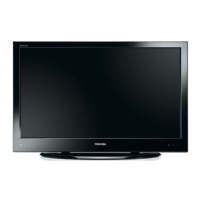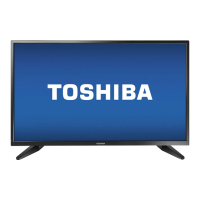
Do you have a question about the Toshiba LV6**D Digital Series and is the answer not in the manual?
| Display Technology | LCD |
|---|---|
| HDMI Ports | 3 |
| Composite Input | 1 |
| Aspect Ratio | 16:9 |
| Refresh Rate | 60 Hz |
| Screen Size | 32 inches |
| Resolution | 1366 x 768 |
| Inputs | HDMI, Component, Composite |
| Dimensions (With Stand) | Varies by screen size |
| Weight (With Stand) | Varies by screen size |
| Sound Output | 10W x 2 |
Compares features between LV and RV series models for installation clarity.
Essential safety guidelines for operating and installing the television to prevent hazards.
Guidance on proper placement, screen cleaning, and important operational notes.
Overview of remote control functions and battery insertion for basic operation.
Instructions for connecting various external devices like decoders and media recorders.
Guides for connecting HDMI, DVI, and PC sources for optimal video and audio.
Instructions for connecting a computer to the TV for display and sound output.
Details on TV input sockets and how to use them with external equipment.
Step-by-step initial setup and quick setup process for the television.
Configuring RF input and detailed manual tuning options for DTV.
Process for automatically scanning and tuning digital and analogue TV channels.
Procedures for manually tuning analogue TV channels for specific stations.
Options for skipping unwanted channels from the channel list.
How to move and save channels to preferred positions for easier access.
Feature for service engineers or direct channel entry for known multiplexes.
Customizing digital TV channels, including manual tuning and order.
Setting TV location mode (Home or Store) for optimal display.
Information regarding the phased switch-off of analogue services.
Manually setting the character set for DVB-C or DVB-T channels.
Rescanning for channels when broadcast information changes.
Basic operation of TV controls, program selection, and time display.
Accessing frequently used options quickly via a menu.
Adjusting volume, mute, dual sound, bass, treble, and balance.
Limits high volume levels to prevent drastic changes between programs.
Provides consistent sound volume regardless of input source or program.
Allows control of audio compression for digital TV programs.
Reduces volume differences when switching between sources or channel types.
Enables an additional narrative sound track for visually impaired individuals.
Configures sound output when headphones are connected.
Selecting different aspect ratios for optimal viewing of various content formats.
Overview of picture controls available in digital and analogue modes.
Adjusts picture position for personal preference, useful for external inputs.
Choosing from preset picture styles like AutoView, Dynamic, Standard, Movie, etc.
Customizing picture settings like backlight, contrast, and brightness.
Resets all picture settings to factory defaults, except Picture Mode.
Enables Base Colour Adjustment for fine-tuning individual colors.
Adjusts the picture's warmth or coolness by changing red or blue tint.
Adjusts brightness, black/white levels, gamma, and noise reduction features.
Fine-tuning picture clarity, colour, and motion with advanced settings.
Manages aspect ratio, screen stretching, blue screen, picture still, and auto format.
Displays the brightness histogram and control curve of each scene.
Shows HDMI signal information like resolution, frame rate, and aspect.
Using the USB port for photo viewing, including automatic and manual opening.
Viewing photos in Multi View, Single View, or Slideshow modes.
Managing panel lock, TV illumination, and programme timers.
Setting on timers to automatically turn the TV on or sleep timers to turn it off.
Accessing digital on-screen information and programme details.
Using the TV guide, genre selection, and searching for programs.
Configuring digital channels, parental locks, and setting a PIN.
Skipping channels, locking specific channels, and managing subtitles/audio.
Common Interface, software upgrades, and license information for TV maintenance.
Configuring PC input, sampling clock, reset, and HDMI specific settings.
Managing input selection, external skip, PC audio, and AV connections.
Configuring the digital audio output for surround sound systems.
Choosing between Fastext and saved pages, and navigating text content.
Using remote buttons for text functions and accessing digital interactive services.
Troubleshooting common issues related to picture, sound, and controls.
Interpreting front panel LED indicators for troubleshooting TV conditions.
Details on product licensing and compliance for video standards.
Technical specifications for acceptable PC signals via the PC terminal.
Accepted video and PC signal formats for HDMI terminals.
Technical specifications and included accessories for the television model.











